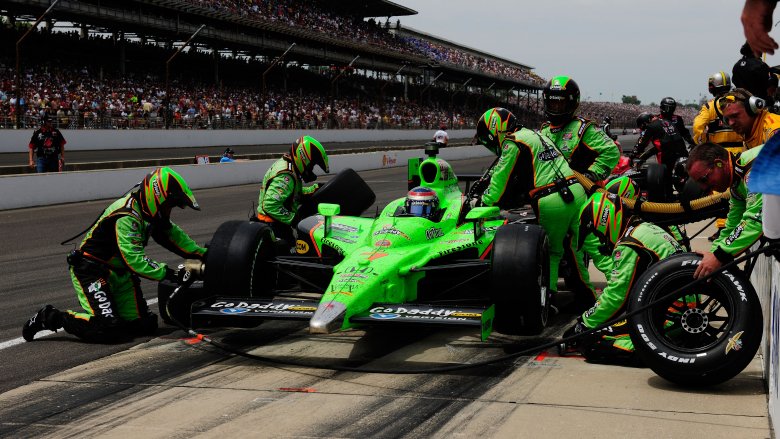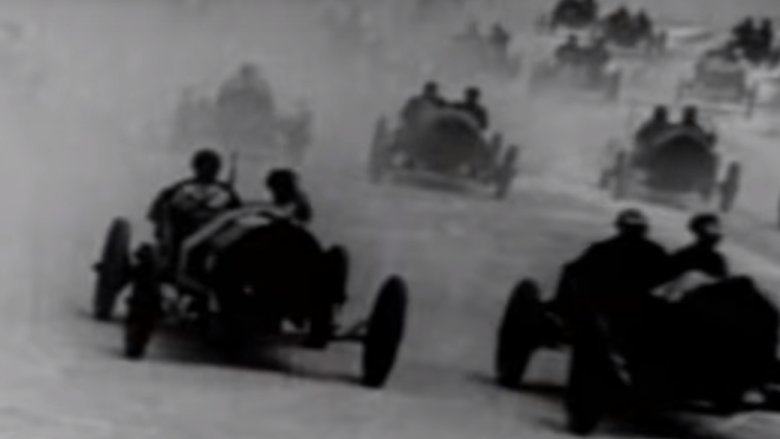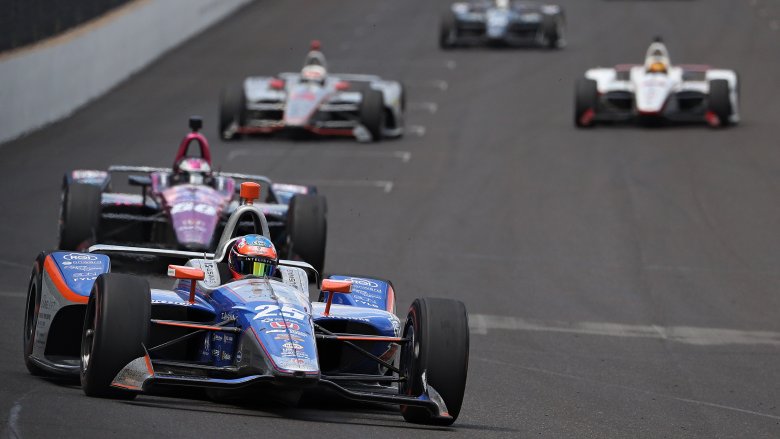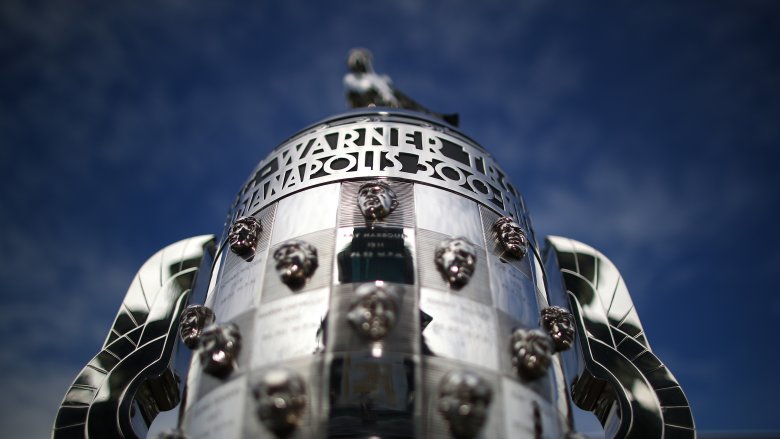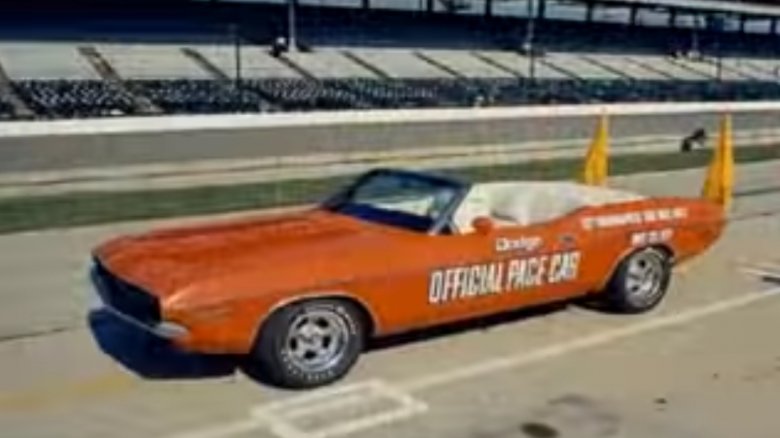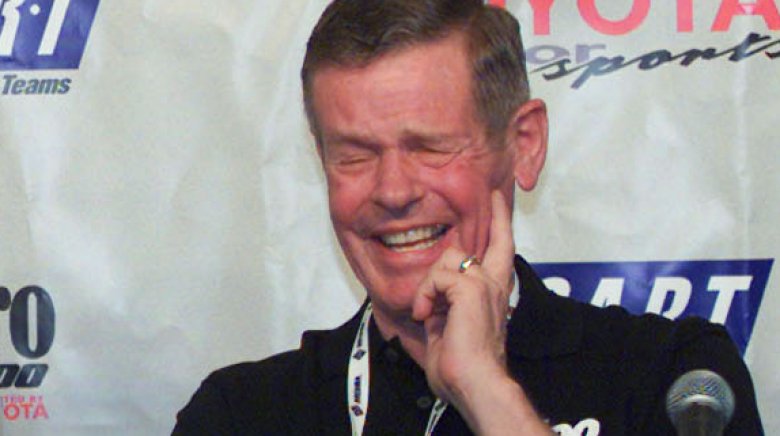The Untold Truth Of The Indy 500
The Indianapolis 500 is the most famous auto race in the world. This Memorial Day weekend race has been thrilling fans since 1911. But there are some things that you might not know about this legendary sporting event, like how that milk tradition got started, and why there's a naked guy on the winner's trophy.
Danica Patrick wasn't the first woman driver there
Danica Patrick is the biggest female name in auto racing and is remembered not just for those obnoxious GoDaddy Super Bowl commercials but for her participating in seven Indy 500 races. She even came in third place in 2009, the best finish for a woman ever at the race.
But Patrick was not the first female driver in the Indy 500. She was the fourth of nine so far. Janet Guthrie first did so in 1977. While she didn't get any Super Bowl ads for being the first woman to compete in the Indy 500, Guthrie's race suit and helmet are in the Smithsonian Institution. And as of this writing, British race car driver Pippa Mann will compete in the race for the fifth consecutive year.
Fun fact: when women race in the Indy 500, they change the "gentlemen, start your engines" introduction to begin with either "lady and gentlemen" or "ladies and gentlemen," depending upon the number of women in the race. Maybe one day, there will be women to cheer in Victory Lane.
Indy drivers pee in their race suit
Time is such a premium in the Indy 500 that pit stop crews have mastered the ability to fill up a race car with gas and change its tires in just six seconds—about the time it takes most regular drivers just to unscrew the gas cap on their car.
But what about the other kind of pit stop—going to the bathroom? Obviously, stopping driving in the race to do so is out of the question. Race car driver Danica Patrick, who finished in the Top 10 of the race five times, explained to Women's Health magazine what race cars drivers do—and it's not wearing adult diapers. "You can go right there in your suit," she said. People do it all the time, but I never have." Patrick said she tried to relieve herself one time in the car, but she just couldn't do it herself, because doing it that way just "feels very unnatural." No kidding. Between sweat and the possibility of other body fluids, that race suit must reek by the end of the Indy 500. Yeesh.
The race began in the first planned horseless town
The Indy 500, called the "greatest spectacle in racing," is in a town called (what else?) Speedway. Carl Fisher, considered the "father" of the race, was one of the town's founders. Speedway was a planned community designed, in Fisher's view, to be the "first horseless city," complete with paved roads and garages.
That wasn't all. Fisher said in 1909 that "the homes would be homes and not the kind of shacks that usually infest an industrial center." And the idea for the town was that it be a "utopia." Think Walt Disney's original idea for EPCOT.
Speedway currently has about 12,000 residents, and the independent town still has a small-town feel even though it's right next to Indianapolis. It isn't really a utopia these days, though, unless Todd Rundgren performing in the area counts.
The original reason for the racetrack was to test cars
Way back when people thought of automobiles as "horseless carriages," some Indianapolis businessmen wanted to help the fledgling auto industry in the state. So in 1909, Carl Fisher, Frank Wheeler, James Allison, and Arthur Newby built what was initially called the Indianapolis Motor Parkway outside of the city. This outdoor track was a place for car companies to try out improvements to automobiles on an actual road, as opposed to driving in, say, a cow pasture.
The track's name was changed shortly after to the Indianapolis Motor Speedway, and the place held small auto races, in the style of horse races at the time. Instead of horses, the competition featured different auto brands and styles competing against each other, to show potential auto buyers the cars' capabilities. Imagine today if you decided whether to buy a Honda Civic, Ford Focus, or Chevrolet Cruze by seeing drivers take them for a spin around the track.
Fisher and his business partners then decided that instead of continuing to hold these races, they'd hold just one massive race each year to garner attention. So the Indianapolis 500 was born in 1911, with a $14,250 purse for the winner (about $350,000 in today's money). The cars have changed, the world has changed, but the race is still held at the same track on Memorial Day weekend each year and with the same number of miles.
For many years, the race was aired on a tape delay
Watching the Indy 500 is a Memorial Day tradition up there with barbecues and beer, but for many years, it wasn't shown live. Instead, only an edited version of the race was aired after the race was over, with some commentary added after the fact. Imagine watching Super Bowl LI after it ended, and only seeing, say, the fourth quarter on. You'd think Tom Brady had the game in the bag all along. Of course, the delayed airing of the Indy 500 was a time before Facebook posts and breaking news would spoil who won the race, but it still seemed pretty retrograde.
Back then, the speedway owners wanted to keep the in-person gate high, so they insisted the race had to air later in the day in the evening, after it was completed. Yes, this sports decision was driven by money. Shocking. As if people in New York and California were going to head to the race if they couldn't see it live.
Finally in 1986, the Indy 500 aired live, but Indianapolis still was blacked out from seeing it as it happened, because race officials wanted the locals to show up in person. In 2016, when the race was sold out for the 100th Indy 500 race, Indy fans in Indy finally got to watch the race live on TV.
Jim Nabors thought he was going to sing the National Anthem instead of Back Home Again in Indiana
The actor best known for being TV's Gomer Pyle is also an excellent singer. And the way he started singing "Back Home Again in Indiana" before the race sounds like something out of The Andy Griffith Show's Mayberry. In 1972, Indianapolis Motor Speedway owner Tony Hulman spotted Nabors sitting at the race. These were the days before celebrities hid in corporate boxes, so Nabors was visible by the start-finish line. Nabors explained that "Mr. Hulman came over to say hello and he recognized me from my shows in Tahoe, and he said, 'Hey, would you like to sing the song?'"
Naturally, Nabors assumed that "the song" would be "The Star-Spangled Banner." But you know what they say about what happens when you assume. When he went to perform, the actor/singer then asked the conductor of the Purdue "All-American" Marching Band what key the song was in. The conductor said there was only one key. "I said, 'No, Star-Spangled Banner's got two keys,'" he recounted. The conductor said, ”'You're not singing that.' I said, 'What the hell am I singing?'" Surprise, surprise.
The bandleader told him, "You're singing the traditional song that opens the race, 'Back Home Again in Indiana.'" Nabors said, "I looked at him kind of funny and said, 'I'm from Alabama. You still want me to do it?'" The conductor then asked Nabors if he knew the song. He responded, "I know the melody, but I don't know the words."
So the singer ended up writing the lyrics to the song on his hand and using them as a reference when performing the tune. Golly, as Gomer Pyle would say. Nabors must have done a good job with that seat-of-the pants rendition, because he sang it again for most of the next 40 Indy 500s before retiring in 2014. Shazam.
The first celebratory bottle of milk was buttermilk
Winners swigging milk after the Indy 500 is the race's most famous tradition. It started after Louis Meyer, a three-time winner, asked for buttermilk after winning in 1936. Sounds pretty disgusting to drink (buttermilk tastes much better when marinating fried chicken), but a tradition was born. According to the Indianapolis Motor Speedway, "an executive with what was then the Milk Foundation was so elated when he saw the moment captured in a photograph in the sports section of his newspaper the following morning that he vowed to make sure it would be repeated in coming years." So yes, shameless marketing was a thing even then.
While the tradition disappeared between 1947 and 1955, it started again in 1956, and Indy 500 winners have been drinking milk ever since. The American Dairy Association even has a whole "Winners Drink Milk" campaign based on the tradition. Each year's Indy 500 winner has a choice of milk these days between whole, skim, and 2 percent (but no chocolate milk), and local dairy farmers present them the milk bottle.
In 1993, Emerson Fittipaldi got booed after winning the Indy 500 for drinking orange juice instead. He owned an orange grove, and was doing marketing of his own. What a rebel.
The trophy is NSFW
Unlike how there's a new trophy in Major League Baseball for each World Series champion to keep (or in the case of the Chicago Cubs, to let the Commissioner's Trophy be manhandled at a rock concert), there's only one trophy for the winner of the Indy 500—the Borg-Warner Trophy. It's like how there's only one Stanley Cup for hockey, only this award is a little, well, racy. Just take a look at the random naked man waving a race flag at the top of the race trophy, a stylistic nod to the ancient Greeks.
Indy 500 race officials present the Borg-Warner Trophy in Victory Lane after each Indy race. The award is made of sterling silver, is nearly five feet five inches high, and weighs 110 pounds. Every single person to win the race has their face crafted in sterling silver and placed on the trophy. To accommodate all of those winners, two bases have been added to the award.
While the trophy is very impressive from a distance, it looks a little weird close up. Between all the faces staring out on the trophy, and the figure on top with full genitalia on display, it's no wonder USA Today calls the Borg-Warner Trophy "one of the creepiest in sports."
And unlike how the Stanley Cup gets passed around in the winning hockey team's organization throughout the year, the Indy 500 winner doesn't get to take home the Borg-Warner trophy itself. About eight months after the race, the winner does get a "Baby Borg" custom-made trophy of their own, though, to keep, with their likeness on it. That award also features the naked flag-waver, too. Thankfully, they don't custom-make the nude figure each year.
The original track was covered in bricks
The Indianapolis Motor Speedway is nicknamed the "Brickyard." The name comes from how the speedway was initially paved with actual bricks. Eventually, the road was replaced with asphalt. Goodbye Indy Brick Road.
But the speedway kept intact a 36-inch wide strip at the start/finish line called the Yard of Bricks. Today, winning Indy 500 drivers kiss the bricks after their victory. However, this tradition wasn't started by that race. In 1996, NASCAR driver Dale Jarrett started this when he and Todd Parrott, his crew chief, puckered up with the ground after Jarrett won the Brickyard 400 at the speedway.
In 1971, the pace car crashed
One of the many traditions of the Indy 500 is having a pace car every year, usually driven by a celebrity, to lead the cars around the track at the beginning. In recent years, the car has been a souped-up Chevrolet Corvette or Camaro, and the winner of the race usually gets to take the car home. Pretty sweet.
What wasn't so sweet was what happened with the 1971 pace car, a Dodge Challenger. Local car dealer Eldon Palmer was driving the orange car with Tony Hulman Jr., owner of the speedway, riding shotgun. Astronaut John Glenn and broadcaster Chris Schenkel were in the back seat. The car was tooling around the track, but when Palmer went to hit the brakes, the equipment locked up. The Challenger then crashed into the photo stand at around 60 miles an hour. Yikes.
Miraculously, despite that speed, nobody died, and everybody was okay in the car. However, Russ Lake, a man taking photos in the stands, broke his hip and leg in the crash and still suffers health issues from it. But he took the accident in stride. "That's my claim to fame," Lake said decades later. "How many people can say they were on a photo stand hit by an Indy 500 pace car?"
As for the pace car itself, the front took a beating in the accident. So 1971 Indy 500 winner Al Unser Sr. received an intact Dodge Charger and not the pace car after the race. But the original vehicle still exists. Palmer restored the car he crashed and sold it to collector Steve Cage for a reported $200,000. Maybe Unser should have asked to receive the original car instead. The pace car is now on display in the American Muscle Car Museum in Florida. Wonder if the brakes were fixed as well.
The 1981 Indy 500 result was decided by an appeals board
Part of the thrill of watching an auto race is to see big names duel it out on the field, with the victory decided in just a few hours. In 1981, though, it took 138 days to decide the Indianapolis 500 race results between Bobby Unser and Mario Andretti.
Unser appeared to win the event at the time by 5.18 seconds and even got to celebrate in Victory Lane. But Pat Patrick, team owner for Mario Andretti, the second-place finisher, filed a protest after the race over Unser reportedly passing cars under a yellow flag. This was something Unser was not penalized for during the race, and something that not a single reporter asked the driver about afterward. The next day, Unser was stunned when he woke up to find that United States Auto Club steward had voted 3-2 to give him a one-lap penalty, making Andretti the winner, even though Andretti did the same offense during the race and did not receive a penalty
Roger Penske, team owner for Unser, hired a high-powered lawyer and fought the decision. The hearings took months, due to the witnesses' auto race schedules. For a sport that prides itself on speed, it took a long time to make this decision. Finally, on October 9, 1981, the USAC appeals board voted 2-1 in favor of Unser but fined him $40,000 for the passing violation. No word on whether Unser celebrated with milk or something a little stronger.

